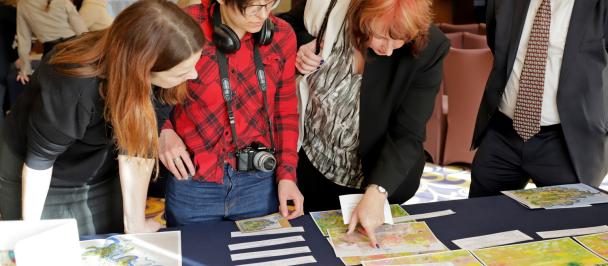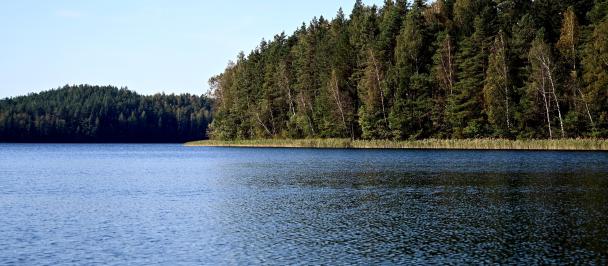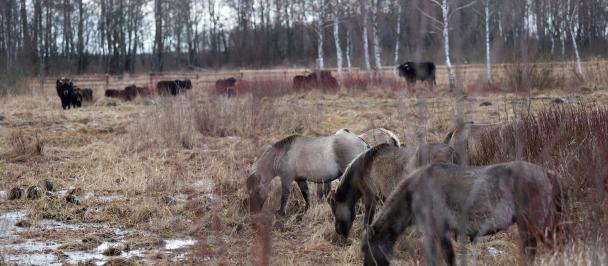Migratory bird tracking helps to understand better the effectiveness of wetlands conservation.
Why Migratory Bird Ringing Is Important for Belarus’ Lowland Bogs Conservation?
May 22, 2024

Wader (Calidris pusilla).
Yaselda bird ringing station
On the banks of the Yaselda River in the Biaroza district of the Brest region, the last evening of April is saturated with bird trills, amphibian calls, and insect humming, all creating an intricate symphony. However, not all of the sounds are real. Many of the bird voices is a recording played for a special purpose.
Nestled at the water's edge, within a wooden gazebo, there is one of Belarus's three bird ringing stations - the Yaselda.

Every few hours, ornithologists embark on a ferry journey across the river to the Sporovskoye lowland bog, one of the country’s largest lowland wetlands.

Lured by sounds, birds fly into nets hung over the swamp. Carefully the ornithologists free them from their traps and place them into special soft bags to be taken to the ringing station. By morning, about ten quivering bags containing feathered captives are hanging beneath the station’s table.


Each bird is weighed, its biometric parameters are measured, and a light ring with an individual number is put on its right leg before it’s released back into the wild.
From 2018 to 2023, 110 species of birds were recorded at the Yaselda station. In 2023 alone, more than 12,000 birds of 101 species underwent ringing.

The Eurasian Wryneck (Jynx torquilla).
Scientific ringing stands as one of the most effective methods for obtaining valuable information about birds and their habitat. Through rings, researchers can identify migration routes, determine the dynamics of species distribution or decline, and the overall state of populations.
Importance of fen mires for migrating birds.
For centuries, the lowland bog had been a haven for countless species of migratory birds, providing crucial stopover points on their long and arduous journeys. For many of them, it is also a vital source of food and nesting grounds. Therefore, the well-being of birds migrating through Belarus largely depends on the state of the lowland bog ecosystem.

Healthy ecosystem of a lowland bog.
Climate change and the impact of human agricultural activities are disrupting the delicate balance in the bog. These factors trigger complex processes that can alter species composition and render the ecosystem unsuitable for native species and migratory birds alike.
The most common changes are due to reed overgrowth. The large-scale reclamation efforts during the 1980s, coupled with increased drought and the cessation of large livestock grazing by the local population in Sporovskoye have led to excessive vegetation.
Additionally, fertilizers from surrounding fields have entered the bog, further exacerbating the challenge.

Tall sedge hummocks are a favored nesting place for the Aquatic Warbler and other small birds.
One of the most visible impacts of such change is the alteration in the abundance and distribution of insects, such as mosquitoes and horseflies - the primary diet for many birds.
This trend has resulted in a decline in certain bird species. For instance, the population of Aquatic Warbler, which are typically found in lowland bogs, has decreased by 95% over the past century.

The European Nightjar (Caprimulgus europaeus) is the only representative of the Nightjar family in Belarus. The bird feeds on insects and hisses loudly when in danger. It flies to South Africa for the winter, returning at the end of April.
Nature-based solutions that help to stop the degradation of “Sporovskoye”.
Since 2006, the United Nations Development Program (UNDP), in partnership with the Ministry of Natural Resources and Environmental Protection of the Republic of Belarus and with the support of the Global Environment Facility (GEF) and the European Union, has implemented about 10 initiatives to find long-term and sustainable nature-based solutions that would prevent the overgrowth of these ecosystems.

According to Vadim Protasevich, the Director of the Nature Reserve, the failure to mow the "Sporovskoye" lowland bog could lead to the loss of its ecosystem functions within a decade.
The most practical solution to combat overgrowth is mechanic mowing. For this purpose, specialized equipment was procured for the reserve, enabling the mowing of reeds, shrubs, and small trees in swampy areas. A test mowing conducted over 3,000-hectare area has demonstrated its high efficiency, leading to the stabilization of populations for certain species of migratory birds in the Sporovskoye bog.
The mowing practice continues to this day. In 2023, a total of 1,140 hectares of the bog were cleared of excess vegetation. Nevertheless, mechanized mowing has its drawbacks, the main one of which is the damage to the topsoil layer.
In search of alternative solutions, the reserve launched an unusual experiment. Now, large wild herbivores such as Tarpan horses and Heck bulls help clean up the vast territory of the reserve. The early results of ‘live mowers’ are promising, offering a glimpse into a more sustainable future for land restoration practices.
Monitoring migratory birds is a crucial tool for assessing the effectiveness of conservation efforts in lowland bogs.
The operation of the ringing station plays a pivotal role in this process, as each bird caught provides valuable insights into both the negative and positive changes occurring within the ecosystem.
For example, this year ornithologists recorded an increase in the number of Jack Snipe (Lymnocryptes minimus) – a rare species listed in the Red Book of the Republic of Belarus. Since the station began operating this year, ornithologists have already ringed seven individuals.

Jack Snipe (Lymnocryptes minimus).
Conservation plays a vital role in maintaining a delicate balance between healthy lowland bog ecosystems and migratory birds. Preservation and sustainable management of bogs are paramount to safeguarding migratory bird populations for future generations.
This understanding, in turn, allows for more effective application and testing of nature-based solutions aimed at restoring these valuable ecosystems in the face of a worsening biodiversity crisis and climate change.

 Locations
Locations



